Empowering Greenhouse Cultivation: Dynamic Factors and Machine Learning Unite for Advanced Microclimate Prediction
Abstract
1. Introduction
1.1. Background
1.2. Related Works
1.3. Proposed Solution
2. Materials and Methods
2.1. Study Area and Materials
2.2. Method
2.2.1. Random Forest (RF)
2.2.2. Artificial Neural Network (ANN)
Backpropagation Neural Network (BPNN)
Long Short-Term Memory Neural Network (LSTM)
2.2.3. Dynamic Factor (DF) Model
2.2.4. Hybrid Model (DF-RF-ANN)
2.3. Evaluation of Model Performance
3. Results and Discussion
3.1. Unobserved Factors Derived from the DF Model
3.2. Factor Identification by RF
3.3. Model Comparison
3.4. Discussion
4. Conclusions
Author Contributions
Funding
Data Availability Statement
Acknowledgments
Conflicts of Interest
Nomenclature
| ANN | Artificial neural networks |
| BPNN | Backpropagation neural networks |
| CO2 | Carbon dioxide (ppm) |
| CWB | Central Weather Bureau |
| DF | Dynamic factor model |
| DSF | Dew point temperature (K) |
| IoT | Internet of Things |
| LSTM | Long short-term memory neural network |
| LWO | Long wave radiation (Wm−2) |
| MAE | Mean absolute error |
| PAR | Photosynthetically active radiation (μmolm−2 s−1) |
| PSF | Surface pressure (hPa) |
| R2 | Coefficient of determination |
| RF | Random Forest |
| RH | Relative humidity (%) |
| SLP | Air pressure (hPa) |
| SWI | Short wave radiation (Wm−2) |
| Temp | Temperature (°C) |
| TSF | Surface temperature (K) |
| VPD | Vapor pressure deficit (hPa) |
Appendix A
| Target | Components | Hyperparameters | ||||||
|---|---|---|---|---|---|---|---|---|
| Temp/ RH/ PAR/ CO2 | DF | Unobserved factor | ||||||
| 1 | ||||||||
| RF | n estimators | Random state | ||||||
| 100 | 42 | |||||||
| ANN | Epoch | Architecture | Activation function | Learning rate | Batch size | Loss function | Optimizer | |
| 150 | 1 input layer 6 hidden layers 1 output layer | ReLU | 0.001 | 32 | MSE | Adam | ||
References
- Seneviratne, S.I.; Zhang, X.; Adnan, M.; Badi, W.; Dereczynski, C.; Di Luca, A.; Vicente-Serrano, S.M.; Wehner, M.; Zhou, B. Chapter 11: Weather and Climate Extreme Events in a Changing Climate. 2021. Available online: https://www.ipcc.ch/report/ar6/wg1/chapter/chapter-11/ (accessed on 10 May 2023).
- Varis, O.; Kajander, T.; Lemmelä, R. Climate and Water: From Climate Models to Water Resources Management and Vice Versa. Clim. Chang. 2004, 66, 321–344. [Google Scholar] [CrossRef]
- Hattermann, F.F.; Kundzewicz, Z.W. Water Framework Directive: Model Supported Implementation; Iwa Publishing: London, UK, 2009. [Google Scholar]
- Baille, M.; Baille, A.; Delmon, D. Microclimate and transpiration of greenhouse rose crops. Agric. For. Meteorol. 1994, 71, 83–97. [Google Scholar] [CrossRef]
- Trigui, M.; Barringtoni, S.; Gauthier, L. Effects of humidity on tomato. Can. Agric. Eng 1999, 41, 135–140. [Google Scholar]
- Kittas, C.; Bartzanas, T. Greenhouse microclimate and dehumidification effectiveness under different ventilator configurations. Build. Environ. 2007, 42, 3774–3784. [Google Scholar] [CrossRef]
- Benni, S.; Tassinari, P.; Bonora, F.; Barbaresi, A.; Torreggiani, D. Efficacy of greenhouse natural ventilation: Environmental monitoring and CFD simulations of a study case. Energy Build. 2016, 125, 276–286. [Google Scholar] [CrossRef]
- Bartzanas, T.; Boulard, T.; Kittas, C. Effect of Vent Arrangement on Windward Ventilation of a Tunnel Greenhouse. Biosyst. Eng. 2004, 88, 479–490. [Google Scholar] [CrossRef]
- Marcelis, L.F.M.; Broekhuijsen, A.G.M.; Nijs, E.M.F.M.; Raaphorst, M.G.M. Quantification of the growth response of light quantity of greenhouse grown crops. Acta Hortic. 2006, 711, 97–104. [Google Scholar] [CrossRef]
- Li, H.; Guo, Y.; Zhao, H.; Wang, Y.; Chow, D. Towards automated greenhouse: A state of the art review on greenhouse monitoring methods and technologies based on internet of things. Comput. Electron. Agric. 2021, 191, 106558. [Google Scholar] [CrossRef]
- Kläring, H.P.; Hauschild, C.; Heißner, A.; Bar-Yosef, B. Model-based control of CO2 concentration in greenhouses at ambient levels increases cucumber yield. Agric. For. Meteorol. 2007, 143, 208–216. [Google Scholar] [CrossRef]
- Boulard, T.; Baille, A.; Lagier, J.; Mermier, M.; Vanderschmitt, E. Water vapour transfer in a plastic house equipped with a dehumidification heat pump. J. Agric. Eng. Res. 1989, 44, 191–204. [Google Scholar] [CrossRef]
- Jolliet, O. HORTITRANS, a Model for Predicting and Optimizing Humidity and Transpiration in Greenhouses. J. Agric. Eng. Res. 1994, 57, 23–37. [Google Scholar] [CrossRef]
- Al Fahoum, A.S.; Abu Al-Haija, A.O.; Alshraideh, H.A. Identification of Coronary Artery Diseases Using Photoplethysmography Signals and Practical Feature Selection Process. Bioengineering 2023, 10, 249. [Google Scholar] [CrossRef]
- Al Fahoum, A.; Ghobon, T.A. Performance Predictions of Sci-Fi Films via Machine Learning. Appl. Sci. 2023, 13, 4312. [Google Scholar] [CrossRef]
- Zheng, W.; Zhao, P.; Chen, G.; Zhou, H.; Tian, Y. A Hybrid Spiking Neurons Embedded LSTM Network for Multivariate Time Series Learning Under Concept-Drift Environment. IEEE Trans. Knowl. Data Eng. 2023, 35, 6561–6574. [Google Scholar] [CrossRef]
- Zhu, C.; Ma, X.; Zhang, C.; Ding, W.; Zhan, J. Information granules-based long-term forecasting of time series via BPNN under three-way decision framework. Inf. Sci. 2023, 634, 696–715. [Google Scholar] [CrossRef]
- Abu-Qasmieh, I.; Fahoum, A.-A.; Alquran, H.; Zyout, A. An Innovative Bispectral Deep Learning Method for Protein Family Classification. Comput. Mater. Contin. 2023, 75, 3971–3991. [Google Scholar] [CrossRef]
- Chang, L.-C.; Amin, M.Z.M.; Yang, S.-N.; Chang, F.-J. Building ANN-Based Regional Multi-Step-Ahead Flood Inundation Forecast Models. Water 2018, 10, 1283. [Google Scholar] [CrossRef]
- Chang, L.-C.; Chang, F.-J.; Yang, S.-N.; Tsai, F.-H.; Chang, T.-H.; Herricks, E.E. Self-organizing maps of typhoon tracks allow for flood forecasts up to two days in advance. Nat. Commun. 2020, 11, 1983. [Google Scholar] [CrossRef]
- Chen, I.T.; Chang, L.-C.; Chang, F.-J. Exploring the spatio-temporal interrelation between groundwater and surface water by using the self-organizing maps. J. Hydrol. 2018, 556, 131–142. [Google Scholar] [CrossRef]
- Kao, I.F.; Zhou, Y.; Chang, L.-C.; Chang, F.-J. Exploring a Long Short-Term Memory based Encoder-Decoder framework for multi-step-ahead flood forecasting. J. Hydrol. 2020, 583, 124631. [Google Scholar] [CrossRef]
- Chang, F.-J.; Tsai, Y.-H.; Chen, P.-A.; Coynel, A.; Vachaud, G. Modeling water quality in an urban river using hydrological factors—Data driven approaches. J. Environ. Manag. 2015, 151, 87–96. [Google Scholar] [CrossRef]
- Bui, D.T.; Khosravi, K.; Tiefenbacher, J.; Nguyen, H.; Kazakis, N. Improving prediction of water quality indices using novel hybrid machine-learning algorithms. Sci. Total Environ. 2020, 721, 137612. [Google Scholar] [CrossRef]
- Chen, T.-H.; Lee, M.-H.; Hsia, I.-W.; Hsu, C.-H.; Yao, M.-H.; Chang, F.-J. Develop a Smart Microclimate Control System for Greenhouses through System Dynamics and Machine Learning Techniques. Water 2022, 14, 3941. [Google Scholar] [CrossRef]
- Jung, D.-H.; Kim, H.S.; Jhin, C.; Kim, H.-J.; Park, S.H. Time-serial analysis of deep neural network models for prediction of climatic conditions inside a greenhouse. Comput. Electron. Agric. 2020, 173, 105402. [Google Scholar] [CrossRef]
- Jung, D.-H.; Lee, T.S.; Kim, K.; Park, S.H. A deep learning model to predict evapotranspiration and relative humidity for moisture control in tomato greenhouses. Agronomy 2022, 12, 2169. [Google Scholar] [CrossRef]
- Ajani, O.S.; Usigbe, M.J.; Aboyeji, E.; Uyeh, D.D.; Ha, Y.; Park, T.; Mallipeddi, R. Greenhouse Micro-Climate Prediction Based on Fixed Sensor Placements: A Machine Learning Approach. Mathematics 2023, 11, 3052. [Google Scholar] [CrossRef]
- Pu Yun, K.; Lee, M.-H.; Sun, W.; Yao, M.-H.; Chang, F.-J. Integrate deep learning and physically-based models for multi-step-ahead microclimate forecasting. Expert Syst. Appl. 2022, 210, 118481. [Google Scholar] [CrossRef]
- Zuur, A.F.; Tuck, I.D.; Bailey, N. Dynamic factor analysis to estimate common trends in fisheries time series. Can. J. Fish. Aquat. Sci. 2003, 60, 542–552. [Google Scholar] [CrossRef]
- Harvey, A.C. Forecasting, Structural Time Series Models and the Kalman Filter; Cambridge University Press: Cambridge, UK, 1990. [Google Scholar] [CrossRef]
- Gil, M.; Leiva-Leon, D.; Pérez, J.J.; Urtasun, A. An Application of Dynamic Factor Models to Nowcast Regional Economic Activity in Spain. Banco de Espana Occasional Paper No. 1904. 2019. Available online: https://papers.ssrn.com/sol3/papers.cfm?abstract_id=3349124 (accessed on 7 October 2023).
- Fuller-Tyszkiewicz, M.; Hartley-Clark, L.; Cummins, R.A.; Tomyn, A.J.; Weinberg, M.K.; Richardson, B. Using dynamic factor analysis to provide insights into data reliability in experience sampling studies. Psychol. Assess. 2017, 29, 1120. [Google Scholar] [CrossRef]
- Kuo, Y.-M.; Wang, S.-W.; Jang, C.-S.; Yeh, N.; Yu, H.-L. Identifying the factors influencing PM2.5 in southern Taiwan using dynamic factor analysis. Atmos. Environ. 2011, 45, 7276–7285. [Google Scholar] [CrossRef]
- Algaba, A.; Borms, S.; Boudt, K.; Verbeken, B. Daily news sentiment and monthly surveys: A mixed-frequency dynamic factor model for nowcasting consumer confidence. Int. J. Forecast. 2023, 39, 266–278. [Google Scholar] [CrossRef]
- Chang, F.J.; Sun, W.; Chung, C.H. Dynamic factor analysis and artificial neural network for estimating pan evaporation at multiple stations in northern Taiwan. Hydrol. Sci. J. 2013, 58, 813–825. [Google Scholar] [CrossRef][Green Version]
- Ali, B.; Mustafa, M.; Henry, M. Dynamic Factor Model and Artificial Neural Network Models: To Combine Forecasts or Combine Models? In Advanced Applications for Artificial Neural Networks; Adel, E.-S., Ed.; IntechOpen: London, UK, 2018; Chapter 5. [Google Scholar] [CrossRef][Green Version]
- Yu, S.; Chen, Y.; Huang, Q.; Kang, Y.; He, R.; Gu, S. Using the random forest method for classification and regression in hydrology. In Advanced Engineering and Technology II, Proceedings of the 2nd Annual Congress on Advanced Engineering and Technology (CAET 2015), Hong Kong, 4–5 April 2015, 1st ed.; CRC Press: Lodon, UK, 2015; p. 213. [Google Scholar] [CrossRef]
- Niu, D.; Wang, K.; Sun, L.; Wu, J.; Xu, X. Short-term photovoltaic power generation forecasting based on random forest feature selection and CEEMD: A case study. Appl. Soft Comput. 2020, 93, 106389. [Google Scholar] [CrossRef]
- Arabameri, A.; Yamani, M.; Pradhan, B.; Melesse, A.; Shirani, K.; Bui, D.T. Novel ensembles of COPRAS multi-criteria decision-making with logistic regression, boosted regression tree, and random forest for spatial prediction of gully erosion susceptibility. Sci. Total Environ. 2019, 688, 903–916. [Google Scholar] [CrossRef]
- Nguyen, H.; Bui, X.N. Predicting blast-induced air overpressure: A robust artificial intelligence system based on artificial neural networks and random forest. Nat. Resour. Res. 2019, 28, 893–907. [Google Scholar] [CrossRef]
- Khajavi, H.; Rastgoo, A. Predicting the carbon dioxide emission caused by road transport using a Random Forest (RF) model combined by Meta-Heuristic Algorithms. Sustain. Cities Soc. 2023, 93, 104503. [Google Scholar] [CrossRef]
- Chen, K.-Y. Combining linear and nonlinear model in forecasting tourism demand. Expert Syst. Appl. 2011, 38, 10368–10376. [Google Scholar] [CrossRef]
- Peng, J.; Xie, Y.; Kang, Z.; Li, H. Application of an Improved Radar Data Assimilation Scheme in Heavy Rain Forecast in Meiyu Period. Plateau Meteorol. 2020, 39, 1007–1022. [Google Scholar] [CrossRef]
- Micheletti, N.; Foresti, L.; Robert, S.; Leuenberger, M.; Pedrazzini, A.; Jaboyedoff, M.; Kanevski, M. Machine Learning Feature Selection Methods for Landslide Susceptibility Mapping. Math. Geosci. 2014, 46, 33–57. [Google Scholar] [CrossRef]
- Breiman, L. Random Forests. Mach. Learn. 2001, 45, 5–32. [Google Scholar] [CrossRef]
- Hastie, T.; Tibshirani, R.; Friedman, J.H.; Friedman, J.H. The Elements of Statistical Learning: Data Mining, Inference, and Prediction; Springer: Berlin, Germany, 2009; Volume 2. [Google Scholar] [CrossRef]
- Hua, L.; Zhang, C.; Sun, W.; Li, Y.; Xiong, J.; Nazir, M.S. An evolutionary deep learning soft sensor model based on random forest feature selection technique for penicillin fermentation process. ISA Trans. 2023, 136, 139–151. [Google Scholar] [CrossRef]
- Nugroho, K.; Noersasongko, E.; Santoso, H.A. Javanese gender speech recognition using deep learning and singular value decomposition. In Proceedings of the 2019 International Seminar on Application for Technology of Information and Communication (iSemantic), Semarang, Indonesia, 21–22 September 2019; pp. 251–254. [Google Scholar]
- Wahyuni, E.S. Arabic speech recognition using MFCC feature extraction and ANN classification. In Proceedings of the 2017 2nd International conferences on Information Technology, Information Systems and Electrical Engineering (ICITISEE), Yogyakarta, Indonesia, 1–2 November 2017; pp. 22–25. [Google Scholar]
- Humphrey, G.B.; Gibbs, M.S.; Dandy, G.C.; Maier, H.R. A hybrid approach to monthly streamflow forecasting: Integrating hydrological model outputs into a Bayesian artificial neural network. J. Hydrol. 2016, 540, 623–640. [Google Scholar] [CrossRef]
- Wang, W.C.; Chau, K.W.; Qiu, L.; Chen, Y.B. Improving forecasting accuracy of medium and long-term runoff using artificial neural network based on EEMD decomposition. Environ. Res. 2015, 139, 46–54. [Google Scholar] [CrossRef]
- Rumelhart, D.E.; Hinton, G.E.; Williams, R.J. Learning Internal Representations by Error Propagation. In Parallel Distributed Processing: Explorations in the Microstructure of Cognition, Volume 1: Foundations; MIT Press: Cambridge, MA, USA, 1986; pp. 318–362. [Google Scholar]
- Zhang, J.; Zhu, Y.; Zhang, X.; Ye, M.; Yang, J. Developing a Long Short-Term Memory (LSTM) based model for predicting water table depth in agricultural areas. J. Hydrol. 2018, 561, 918–929. [Google Scholar] [CrossRef]
- Yin, H.; Zhang, X.; Wang, F.; Zhang, Y.; Xia, R.; Jin, J. Rainfall-runoff modeling using LSTM-based multi-state-vector sequence-to-sequence model. J. Hydrol. 2021, 598, 126378. [Google Scholar] [CrossRef]
- Aruoba, S.B.; Diebold, F.X.; Scotti, C. Real-Time Measurement of Business Conditions. J. Bus. Econ. Stat. 2009, 27, 417–427. [Google Scholar] [CrossRef]
- Seabold, S.; Perktold, J. Statsmodels: Econometric and statistical modeling with python. In Proceedings of the 9th Python in Science Conference, Austin, TX, USA, 28 June–3 July 2010. [Google Scholar]
- El-Sharkawy, M.A.; Cock, J.H.; Del Pilar Hernandez, A. Stomatal response to air humidity and its relation to stomatal density in a wide range of warm climate species. Photosynth. Res. 1985, 7, 137–149. [Google Scholar] [CrossRef]
- Pellicciotti, F.; Brock, B.; Strasser, U.; Burlando, P.; Funk, M.; Corripio, J. An enhanced temperature-index glacier melt model including the shortwave radiation balance: Development and testing for Haut Glacier d’Arolla, Switzerland. J. Glaciol. 2005, 51, 573–587. [Google Scholar] [CrossRef]
- Livingstone, D.M.; Lotter, A.F. The relationship between air and water temperatures in lakes of the Swiss Plateau: A case study with pal\sgmaelig;olimnological implications. J. Paleolimnol. 1998, 19, 181–198. [Google Scholar] [CrossRef]
- Dirmeyer, P.A.; Gentine, P.; Ek, M.B.; Balsamo, G. Chapter 8—Land Surface Processes Relevant to Sub-seasonal to Seasonal (S2S) Prediction. In Sub-Seasonal to Seasonal Prediction; Robertson, A.W., Vitart, F., Eds.; Elsevier: Amsterdam, The Netherlands, 2019; pp. 165–181. [Google Scholar] [CrossRef]
- Eaton, M.; Kells, S.A. Use of vapor pressure deficit to predict humidity and temperature effects on the mortality of mold mites, Tyrophagus putrescentiae. Exp. Appl. Acarol. 2009, 47, 201–213. [Google Scholar] [CrossRef]
- De Swaef, T.; Driever, S.M.; Van Meulebroek, L.; Vanhaecke, L.; Marcelis, L.F.M.; Steppe, K. Understanding the effect of carbon status on stem diameter variations. Ann. Bot. 2012, 111, 31–46. [Google Scholar] [CrossRef] [PubMed]
- Smith, E.L. Photosynthesis in Relation to Light and Carbon Dioxide. Proc. Natl. Acad. Sci. USA 1936, 22, 504–511. [Google Scholar] [CrossRef] [PubMed]
- Carruthers, T.J.B.; Longstaff, B.J.; Dennison, W.C.; Abal, E.G.; Aioi, K. Chapter 19—Measurement of light penetration in relation to seagrass. In Global Seagrass Research Methods; Short, F.T., Coles, R.G., Eds.; Elsevier Science: Amsterdam, The Netherlands, 2001; pp. 369–392. [Google Scholar] [CrossRef]
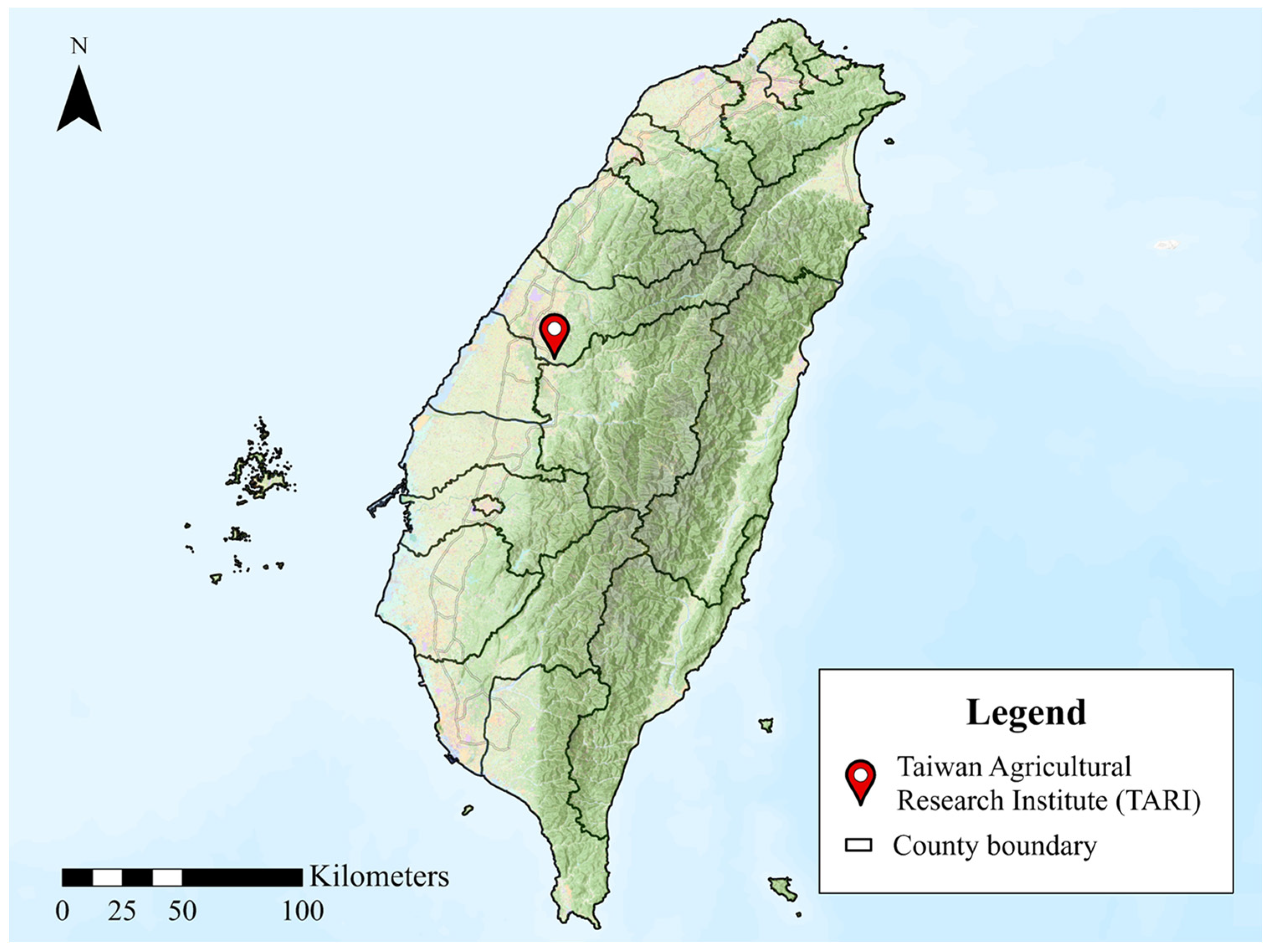
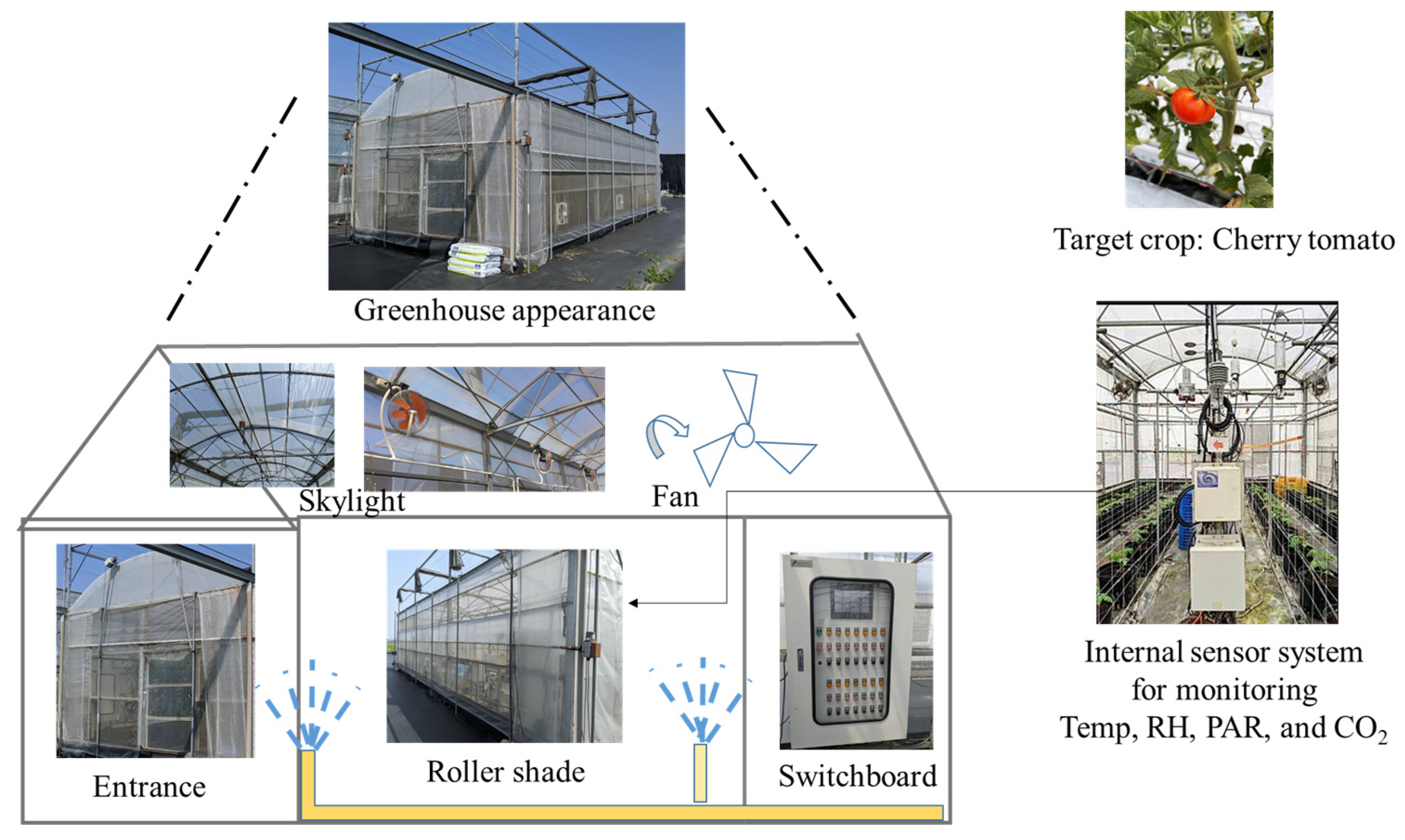
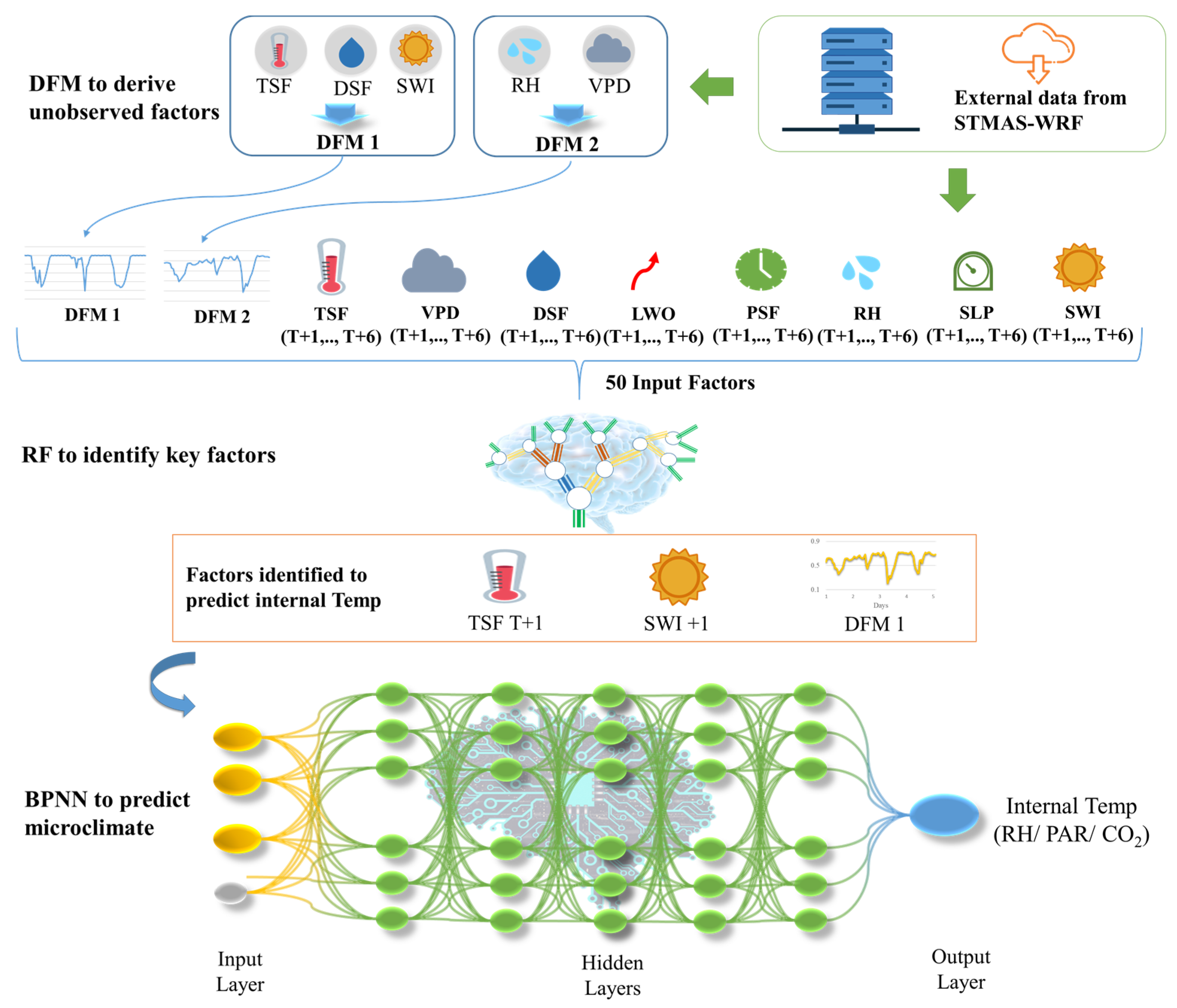
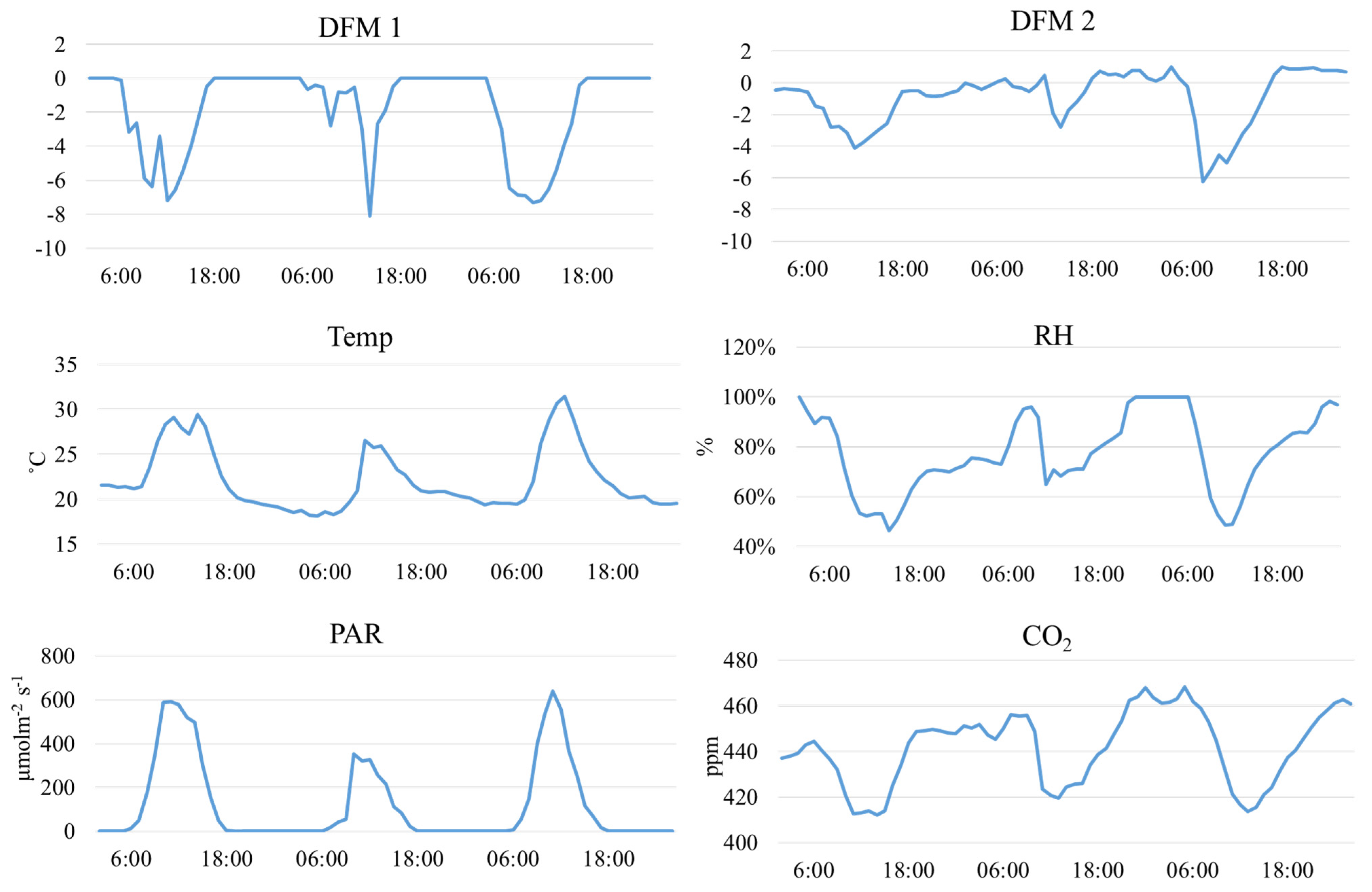

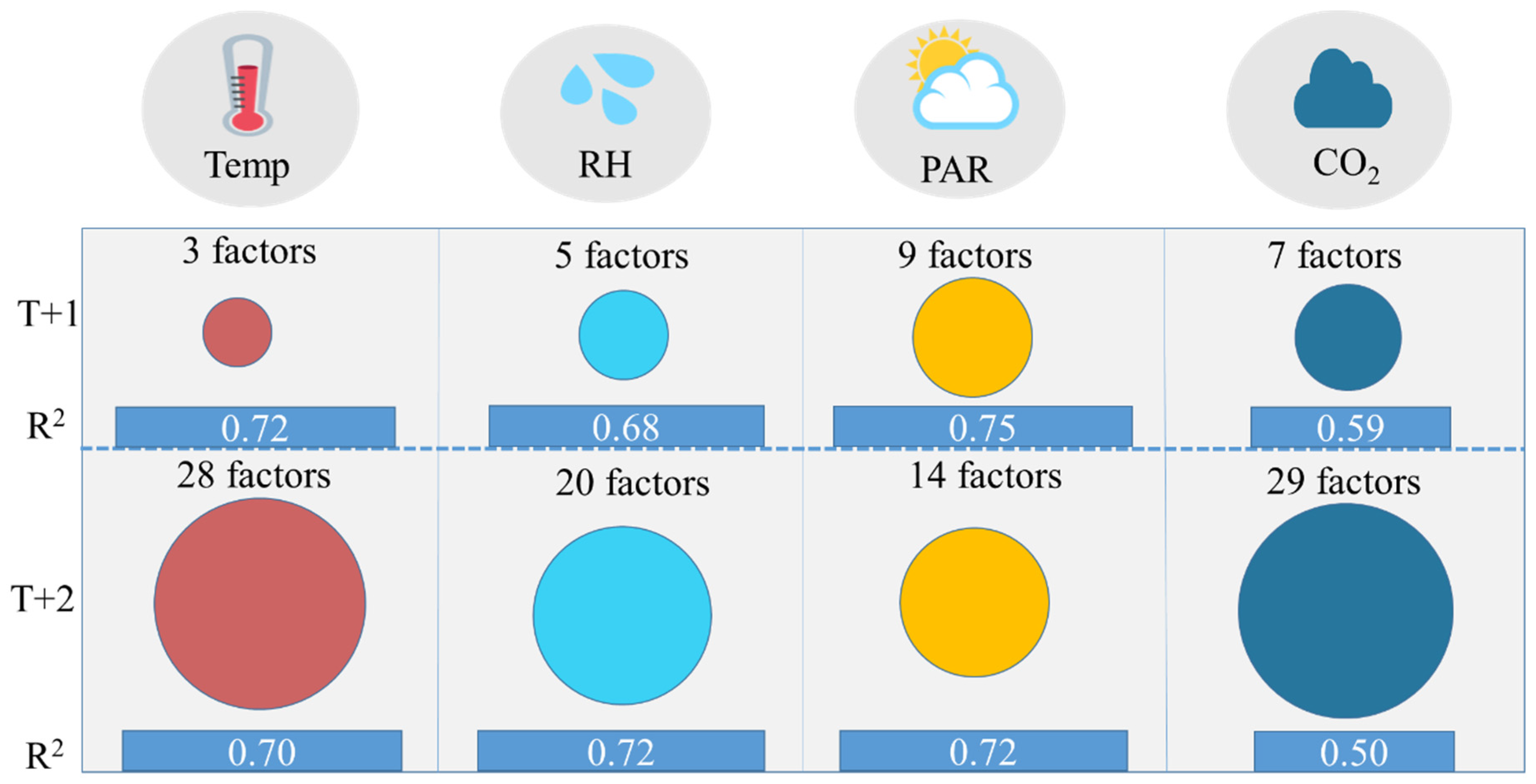
| Temp | RH | |||||||||||
|---|---|---|---|---|---|---|---|---|---|---|---|---|
| Rank | Factor a | Model T1 | Model T2 | Model T3 | Model T4 c | Model T5 | Rank | Factor | Model R1 | Model R2 | Model R3 | Model R4 |
| 1 | TSF T + 1 | ✓ | ✓ | ✓ | ✓ | ✓ | 1 | SWI T + 1 | ✓ | ✓ | ✓ | ✓ |
| 2 | SWI T + 1 | ✓ | ✓ | ✓ | ✓ | ✓ | 2 | DFM 1 | ✓ | ✓ | ✓ | ✓ |
| 3 | DFM 1 | ✓ | ✓ | ✓ | ✓ | 3 | RH T + 1 | ✓ | ✓ | ✓ | ✓ | |
| 4 | SWI T + 2 | ✓ | ✓ | ✓ | 4 | VPD T + 1 | ✓ | ✓ | ✓ | ✓ | ||
| 5 | TSF T + 2 | ✓ | ✓ | ✓ | 5 | SWI T + 6 | ✓ | ✓ | ✓ | |||
| 6 | LWO T + 1 | ✓ | ✓ | 6 | LWO T + 1 | ✓ | ✓ | |||||
| 7 | LWO T + 2 | ✓ | ✓ | 7 | DFM 2 | ✓ | ✓ | |||||
| 8 | VPD T + 1 | ✓ | 8 | LWO T + 2 | ✓ | |||||||
| 9 | LWO T + 4 | ✓ | 9 | RH T + 2 | ✓ | |||||||
| 10 | DFM 2 | ✓ | 10 | LWO T + 5 | ||||||||
| R2 Performance b | 0.56 | 0.57 | 0.63 | 0.72 c | 0.60 | R2 Performance | −0.01 | −0.01 | 0.68 | 0.66 | ||
| PAR | CO2 | |||||||||||
| Rank | Factor | Model P1 | Model P2 | Model P3 | Model P4 | Rank | Factor | Model C1 | Model C2 | Model C3 | Model C4 | |
| 1 | SWI T + 2 | ✓ | ✓ | ✓ | ✓ | 1 | VPD T + 1 | ✓ | ✓ | ✓ | ✓ | |
| 2 | VPD T + 1 | ✓ | ✓ | ✓ | ✓ | 2 | DFM 2 | ✓ | ✓ | ✓ | ✓ | |
| 3 | SWI T + 3 | ✓ | ✓ | ✓ | ✓ | 3 | TSF T + 1 | ✓ | ✓ | ✓ | ✓ | |
| 4 | SWI T + 1 | ✓ | ✓ | ✓ | ✓ | 4 | SWI T + 1 | ✓ | ✓ | ✓ | ✓ | |
| 5 | DFM 2 | ✓ | ✓ | ✓ | ✓ | 5 | SWI T + 6 | ✓ | ✓ | ✓ | ✓ | |
| 6 | DFM 1 | ✓ | ✓ | ✓ | 6 | DFM 1 | ✓ | ✓ | ✓ | |||
| 7 | TSF T + 1 | ✓ | ✓ | ✓ | 7 | TSF T + 2 | ✓ | ✓ | ||||
| 8 | LWO T + 1 | ✓ | ✓ | 8 | RH T + 6 | ✓ | ||||||
| 9 | SWI T + 4 | ✓ | ✓ | 9 | DSF T + 6 | ✓ | ||||||
| 10 | LWO T + 4 | ✓ | 10 | LWO T + 1 | ||||||||
| R2 Performance | 0.70 | 0.75 | 0.74 | 0.72 | R2 Performance | 0.17 | 0.59 | 0.28 | 0.39 | |||
| Model | Target Outputs | R2 | MAE |
|---|---|---|---|
| DF-RF-ANN a (Model T4 for Temp; Model RH3 for RH; Model P2 for PAR; & Model C2 for CO2) | Temp (°C) | 0.72 (7.69 b, 1.32 c) | 1.97 (19.24 b, 9.38 c) |
| RH (%) | 0.68 (22.51, 9.54) | 0.10 (9.2, 7.47) | |
| PAR (μmolm−2 s−1) | 0.75 (1.83, 12.13) | 76.39 (5.79, 17.02) | |
| CO2 (ppm) | 0.59 (38.82, 8.14) | 10.14 (17.92, 7.63) | |
| LSTM (48 input factors) | Temp (°C) | 0.71 (6.28 b) | 2.17 (10.88 b) |
| RH (%) | 0.62 (11.84) | 0.11 (1.87) | |
| PAR (μmolm−2 s−1) | 0.67 (−9.19) | 92.07 (−13.53) | |
| CO2 (ppm) | 0.55 (28.37) | 10.98 (−11.14) | |
| BPNN (48 input factors) | Temp (°C) | 0.66 | 2.44 |
| RH (%) | 0.55 | 0.11 | |
| PAR (μmolm−2 s−1) | 0.74 | 81.09 | |
| CO2 (ppm) | 0.43 | 12.35 |
Disclaimer/Publisher’s Note: The statements, opinions and data contained in all publications are solely those of the individual author(s) and contributor(s) and not of MDPI and/or the editor(s). MDPI and/or the editor(s) disclaim responsibility for any injury to people or property resulting from any ideas, methods, instructions or products referred to in the content. |
© 2023 by the authors. Licensee MDPI, Basel, Switzerland. This article is an open access article distributed under the terms and conditions of the Creative Commons Attribution (CC BY) license (https://creativecommons.org/licenses/by/4.0/).
Share and Cite
Sun, W.; Chang, F.-J. Empowering Greenhouse Cultivation: Dynamic Factors and Machine Learning Unite for Advanced Microclimate Prediction. Water 2023, 15, 3548. https://doi.org/10.3390/w15203548
Sun W, Chang F-J. Empowering Greenhouse Cultivation: Dynamic Factors and Machine Learning Unite for Advanced Microclimate Prediction. Water. 2023; 15(20):3548. https://doi.org/10.3390/w15203548
Chicago/Turabian StyleSun, Wei, and Fi-John Chang. 2023. "Empowering Greenhouse Cultivation: Dynamic Factors and Machine Learning Unite for Advanced Microclimate Prediction" Water 15, no. 20: 3548. https://doi.org/10.3390/w15203548
APA StyleSun, W., & Chang, F.-J. (2023). Empowering Greenhouse Cultivation: Dynamic Factors and Machine Learning Unite for Advanced Microclimate Prediction. Water, 15(20), 3548. https://doi.org/10.3390/w15203548







